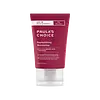The Jojoba Company Overnight Multi-biotic Moisture Cream Versus Paula's Choice Skin Recovery Replenishing Moisturizer
What's inside
What's inside
 Key Ingredients
Key Ingredients

 Benefits
Benefits

 Concerns
Concerns

 Ingredients Side-by-side
Ingredients Side-by-side

Water
Skin ConditioningSimmondsia Chinensis Seed Oil
EmollientJojoba Esters
EmollientLactococcus Ferment Lysate
Skin ConditioningHydrogenated Sunflower Seed Oil Glyceryl Esters
EmulsifyingHydrogenated Sunflower Seed Oil Polyglyceryl-3 Esters
EmulsifyingStearyl Alcohol
EmollientJojoba Alcohol
EmollientCetearyl Alcohol
EmollientButyrospermum Parkii Butter
Skin ConditioningSodium Stearoyl Lactylate
EmulsifyingPentylene Glycol
Skin ConditioningCetyl Alcohol
EmollientTremella Fuciformis Extract
HumectantHydrolyzed Tremella Fuciformis Sporocarp Extract
AntioxidantGlycerin
HumectantPropanediol
SolventHydroxyacetophenone
AntioxidantXanthan Gum
EmulsifyingCitrus Nobilis Oil
MaskingPelargonium Roseum Leaf Oil
PerfumingTocopherol
AntioxidantBenzyl Alcohol
PerfumingSalicylic Acid
MaskingSorbic Acid
PreservativeLimonene
PerfumingCitronellol
PerfumingGeraniol
PerfumingLinalool
PerfumingWater, Simmondsia Chinensis Seed Oil, Jojoba Esters, Lactococcus Ferment Lysate, Hydrogenated Sunflower Seed Oil Glyceryl Esters, Hydrogenated Sunflower Seed Oil Polyglyceryl-3 Esters, Stearyl Alcohol, Jojoba Alcohol, Cetearyl Alcohol, Butyrospermum Parkii Butter, Sodium Stearoyl Lactylate, Pentylene Glycol, Cetyl Alcohol, Tremella Fuciformis Extract, Hydrolyzed Tremella Fuciformis Sporocarp Extract, Glycerin, Propanediol, Hydroxyacetophenone, Xanthan Gum, Citrus Nobilis Oil, Pelargonium Roseum Leaf Oil, Tocopherol, Benzyl Alcohol, Salicylic Acid, Sorbic Acid, Limonene, Citronellol, Geraniol, Linalool
Water
Skin ConditioningCetearyl Ethylhexanoate
EmollientButylene Glycol
HumectantGlycereth-26
HumectantOenothera Biennis Oil
EmollientCetyl Alcohol
EmollientNeopentyl Glycol Diheptanoate
EmollientCyclopentasiloxane
EmollientStearic Acid
CleansingGlyceryl Stearate
EmollientPEG-100 Stearate
Glycerin
HumectantCyclohexasiloxane
EmollientDimethicone
EmollientPanthenol
Skin ConditioningPalmitoyl Tripeptide-1
Skin ConditioningPalmitoyl Tetrapeptide-7
Skin ConditioningSodium Hyaluronate
HumectantTocopheryl Linoleate
AntioxidantTocopheryl Acetate
AntioxidantTocopherol
AntioxidantMagnesium Ascorbyl Phosphate
AntioxidantAscorbyl Palmitate
AntioxidantDipotassium Glycyrrhizate
HumectantSodium PCA
HumectantAnthemis Nobilis Flower Extract
MaskingAloe Barbadensis Leaf Juice
Skin ConditioningSodium Ascorbyl Phosphate
AntioxidantLinoleic Acid
CleansingLinolenic Acid
CleansingPentaerythrityl Tetra-Di-T-Butyl Hydroxyhydrocinnamate
AntioxidantSaccharide Isomerate
HumectantHydroxypropyl Guar
Emulsion StabilisingAllantoin
Skin ConditioningRosa Moschata Seed Oil
EmollientPolysorbate 20
EmulsifyingCetyl Hydroxyethylcellulose
Emulsion StabilisingCarbomer
Emulsion StabilisingSodium Citrate
BufferingTrisodium EDTA
Batyl Alcohol
EmollientSodium Hydroxide
BufferingPhenoxyethanol
PreservativeChlorphenesin
AntimicrobialBenzoic Acid
MaskingSorbic Acid
PreservativeWater, Cetearyl Ethylhexanoate, Butylene Glycol, Glycereth-26, Oenothera Biennis Oil, Cetyl Alcohol, Neopentyl Glycol Diheptanoate, Cyclopentasiloxane, Stearic Acid, Glyceryl Stearate, PEG-100 Stearate, Glycerin, Cyclohexasiloxane, Dimethicone, Panthenol, Palmitoyl Tripeptide-1, Palmitoyl Tetrapeptide-7, Sodium Hyaluronate, Tocopheryl Linoleate, Tocopheryl Acetate, Tocopherol, Magnesium Ascorbyl Phosphate, Ascorbyl Palmitate, Dipotassium Glycyrrhizate, Sodium PCA, Anthemis Nobilis Flower Extract, Aloe Barbadensis Leaf Juice, Sodium Ascorbyl Phosphate, Linoleic Acid, Linolenic Acid, Pentaerythrityl Tetra-Di-T-Butyl Hydroxyhydrocinnamate, Saccharide Isomerate, Hydroxypropyl Guar, Allantoin, Rosa Moschata Seed Oil, Polysorbate 20, Cetyl Hydroxyethylcellulose, Carbomer, Sodium Citrate, Trisodium EDTA, Batyl Alcohol, Sodium Hydroxide, Phenoxyethanol, Chlorphenesin, Benzoic Acid, Sorbic Acid
 Reviews
Reviews

Ingredients Explained
These ingredients are found in both products.
Ingredients higher up in an ingredient list are typically present in a larger amount.
Cetyl Alcohol is a fatty alcohol. Fatty Alcohols are most often used as an emollient or to thicken a product.
Its main roles are:
Though it has "alcohol" in the name, it is not related to denatured alcohol or ethyl alcohol.
The FDA allows products labeled "alcohol-free" to have fatty alcohols.
Learn more about Cetyl AlcoholGlycerin is already naturally found in your skin. It helps moisturize and protect your skin.
A study from 2016 found glycerin to be more effective as a humectant than AHAs and hyaluronic acid.
As a humectant, it helps the skin stay hydrated by pulling moisture to your skin. The low molecular weight of glycerin allows it to pull moisture into the deeper layers of your skin.
Hydrated skin improves your skin barrier; Your skin barrier helps protect against irritants and bacteria.
Glycerin has also been found to have antimicrobial and antiviral properties. Due to these properties, glycerin is often used in wound and burn treatments.
In cosmetics, glycerin is usually derived from plants such as soybean or palm. However, it can also be sourced from animals, such as tallow or animal fat.
This ingredient is organic, colorless, odorless, and non-toxic.
Glycerin is the name for this ingredient in American English. British English uses Glycerol/Glycerine.
Learn more about GlycerinSorbic Acid is a preservative. It is the most commonly used food preservative in the world.
Sorbic Acid is a natural antibiotic and highly effective at preventing the growth of fungus. It is less effective against bacteria.
Potassium Sorbate, another commonly-used preservative, is the potassium salt of Sorbic Acid.
Sorbic Acid may worsen eczema. We recommend speaking with a professional if you have any concerns.
Potassium sorbate and sorbic acid can be found in baked goods, cheeses, dried meats, dried fruit, ice cream, pickles, wine, yogurt, and more.
Learn more about Sorbic AcidTocopherol (also known as Vitamin E) is a common antioxidant used to help protect the skin from free-radicals and strengthen the skin barrier. It's also fat soluble - this means our skin is great at absorbing it.
Vitamin E also helps keep your natural skin lipids healthy. Your lipid skin barrier naturally consists of lipids, ceramides, and fatty acids. Vitamin E offers extra protection for your skin’s lipid barrier, keeping your skin healthy and nourished.
Another benefit is a bit of UV protection. Vitamin E helps reduce the damage caused by UVB rays. (It should not replace your sunscreen). Combining it with Vitamin C can decrease sunburned cells and hyperpigmentation after UV exposure.
You might have noticed Vitamin E + C often paired together. This is because it is great at stabilizing Vitamin C. Using the two together helps increase the effectiveness of both ingredients.
There are often claims that Vitamin E can reduce/prevent scarring, but these claims haven't been confirmed by scientific research.
Learn more about TocopherolWater. It's the most common cosmetic ingredient of all. You'll usually see it at the top of ingredient lists, meaning that it makes up the largest part of the product.
So why is it so popular? Water most often acts as a solvent - this means that it helps dissolve other ingredients into the formulation.
You'll also recognize water as that liquid we all need to stay alive. If you see this, drink a glass of water. Stay hydrated!
Learn more about Water